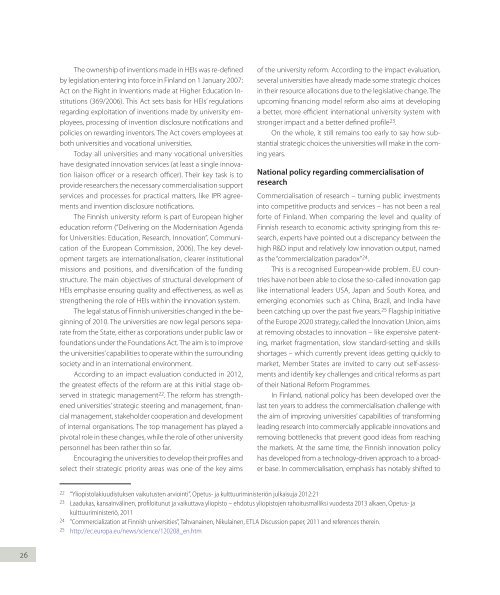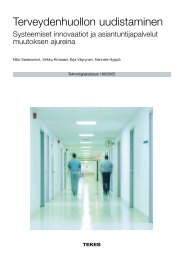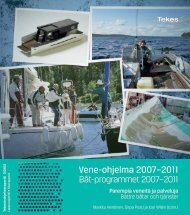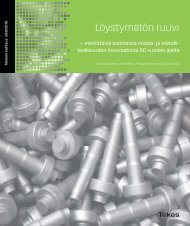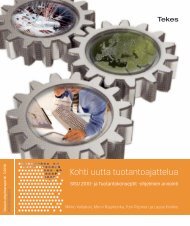Evaluation of TULI Programmes - Tekes
Evaluation of TULI Programmes - Tekes
Evaluation of TULI Programmes - Tekes
You also want an ePaper? Increase the reach of your titles
YUMPU automatically turns print PDFs into web optimized ePapers that Google loves.
The ownership <strong>of</strong> inventions made in HEIs was re-defined<br />
by legislation entering into force in Finland on 1 January 2007:<br />
Act on the Right in Inventions made at Higher Education Institutions<br />
(369/2006). This Act sets basis for HEIs’ regulations<br />
regarding exploitation <strong>of</strong> inventions made by university employees,<br />
processing <strong>of</strong> invention disclosure notifications and<br />
policies on rewarding inventors. The Act covers employees at<br />
both universities and vocational universities.<br />
Today all universities and many vocational universities<br />
have designated innovation services (at least a single innovation<br />
liaison <strong>of</strong>ficer or a research <strong>of</strong>ficer). Their key task is to<br />
provide researchers the necessary commercialisation support<br />
services and processes for practical matters, like IPR agreements<br />
and invention disclosure notifications.<br />
The Finnish university reform is part <strong>of</strong> European higher<br />
education reform (“Delivering on the Modernisation Agenda<br />
for Universities: Education, Research, Innovation”, Communication<br />
<strong>of</strong> the European Commission, 2006). The key development<br />
targets are internationalisation, clearer institutional<br />
missions and positions, and diversification <strong>of</strong> the funding<br />
structure. The main objectives <strong>of</strong> structural development <strong>of</strong><br />
HEIs emphasise ensuring quality and effectiveness, as well as<br />
strengthening the role <strong>of</strong> HEIs within the innovation system.<br />
The legal status <strong>of</strong> Finnish universities changed in the beginning<br />
<strong>of</strong> 2010. The universities are now legal persons separate<br />
from the State, either as corporations under public law or<br />
foundations under the Foundations Act. The aim is to improve<br />
the universities’ capabilities to operate within the surrounding<br />
society and in an international environment.<br />
According to an impact evaluation conducted in 2012,<br />
the greatest effects <strong>of</strong> the reform are at this initial stage observed<br />
in strategic management 22 . The reform has strengthened<br />
universities’ strategic steering and management, financial<br />
management, stakeholder cooperation and development<br />
<strong>of</strong> internal organisations. The top management has played a<br />
pivotal role in these changes, while the role <strong>of</strong> other university<br />
personnel has been rather thin so far.<br />
Encouraging the universities to develop their pr<strong>of</strong>iles and<br />
select their strategic priority areas was one <strong>of</strong> the key aims<br />
<strong>of</strong> the university reform. According to the impact evaluation,<br />
several universities have already made some strategic choices<br />
in their resource allocations due to the legislative change. The<br />
upcoming financing model reform also aims at developing<br />
a better, more efficient international university system with<br />
stronger impact and a better defined pr<strong>of</strong>ile 23 .<br />
On the whole, it still remains too early to say how substantial<br />
strategic choices the universities will make in the coming<br />
years.<br />
National policy regarding commercialisation <strong>of</strong><br />
research<br />
Commercialisation <strong>of</strong> research – turning public investments<br />
into competitive products and services – has not been a real<br />
forte <strong>of</strong> Finland. When comparing the level and quality <strong>of</strong><br />
Finnish research to economic activity springing from this research,<br />
experts have pointed out a discrepancy between the<br />
high R&D input and relatively low innovation output, named<br />
as the “commercialization paradox” 24 .<br />
This is a recognised European-wide problem. EU countries<br />
have not been able to close the so-called innovation gap<br />
like international leaders USA, Japan and South Korea, and<br />
emerging economies such as China, Brazil, and India have<br />
been catching up over the past five years. 25 Flagship initiative<br />
<strong>of</strong> the Europe 2020 strategy, called the Innovation Union, aims<br />
at removing obstacles to innovation – like expensive patenting,<br />
market fragmentation, slow standard-setting and skills<br />
shortages – which currently prevent ideas getting quickly to<br />
market, Member States are invited to carry out self-assessments<br />
and identify key challenges and critical reforms as part<br />
<strong>of</strong> their National Reform <strong>Programmes</strong>.<br />
In Finland, national policy has been developed over the<br />
last ten years to address the commercialisation challenge with<br />
the aim <strong>of</strong> improving universities’ capabilities <strong>of</strong> transforming<br />
leading research into commercially applicable innovations and<br />
removing bottlenecks that prevent good ideas from reaching<br />
the markets. At the same time, the Finnish innovation policy<br />
has developed from a technology-driven approach to a broader<br />
base. In commercialisation, emphasis has notably shifted to<br />
22 “Yliopistolakiuudistuksen vaikutusten arviointi”, Opetus- ja kulttuuriministeriön julkaisuja 2012:21<br />
23 Laadukas, kansainvälinen, pr<strong>of</strong>iloitunut ja vaikuttava yliopisto – ehdotus yliopistojen rahoitusmalliksi vuodesta 2013 alkaen, Opetus- ja<br />
kulttuuriministeriö, 2011<br />
24 ”Commercialization at Finnish universities”, Tahvanainen, Nikulainen, ETLA Discussion paper, 2011 and references therein.<br />
25 http://ec.europa.eu/news/science/120208_en.htm<br />
26


